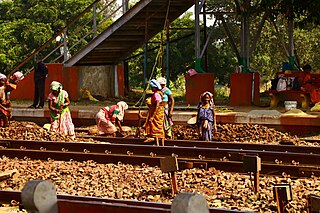Related Research Articles

Labour economics, or labor economics, seeks to understand the functioning and dynamics of the markets for wage labour. Labour is a commodity that is supplied by labourers, usually in exchange for a wage paid by demanding firms. Because these labourers exist as parts of a social, institutional, or political system, labour economics must also account for social, cultural and political variables.
A minimum wage is the lowest remuneration that employers can legally pay their employees—the price floor below which employees may not sell their labor. Most countries had introduced minimum wage legislation by the end of the 20th century. Because minimum wages increase the cost of labor, companies often try to avoid minimum wage laws by using gig workers, by moving labor to locations with lower or nonexistent minimum wages, or by automating job functions.

Unemployment, according to the OECD, is people above a specified age not being in paid employment or self-employment but currently available for work during the reference period.
Employment is a relationship between two parties regulating the provision of paid labour services. Usually based on a contract, one party, the employer, which might be a corporation, a not-for-profit organization, a co-operative, or any other entity, pays the other, the employee, in return for carrying out assigned work. Employees work in return for wages, which can be paid on the basis of an hourly rate, by piecework or an annual salary, depending on the type of work an employee does, the prevailing conditions of the sector and the bargaining power between the parties. Employees in some sectors may receive gratuities, bonus payments or stock options. In some types of employment, employees may receive benefits in addition to payment. Benefits may include health insurance, housing, disability insurance. Employment is typically governed by employment laws, organisation or legal contracts.

Temporary work or temporary employment refers to an employment situation where the working arrangement is limited to a certain period of time based on the needs of the employing organization. Temporary employees are sometimes called "contractual", "seasonal", "interim", "casual staff", "outsourcing", "freelance"; or the words may be shortened to "temps". In some instances, temporary, highly skilled professionals refer to themselves as consultants. Increasingly, executive-level positions are also filled with Interim Executives or Fractional Executives.

In Japan, a freeter is a person who is unemployed or lacks full-time employment, excluding housewives and students. Freeters average 15 to 34 years of age.
The Current Population Survey (CPS) is a monthly survey of about 60,000 U.S. households conducted by the United States Census Bureau for the Bureau of Labor Statistics (BLS). The BLS uses the data to publish reports early each month called the Employment Situation. This report provides estimates of the unemployment rate and the numbers of employed and unemployed people in the United States based on the CPS. A readable Employment Situation Summary is provided monthly. Annual estimates include employment and unemployment in large metropolitan areas. Researchers can use some CPS microdata to investigate these or other topics.

The working poor are working people whose incomes fall below a given poverty line due to low-income jobs and low familial household income. These are people who spend at least 27 weeks in a year working or looking for employment, but remain under the poverty threshold.
The primary labor market is a market that generally consists of high-wage paying jobs, social security, and longer-lasting careers, but others define it as jobs that "require formal education", but in addition to white collar jobs like teaching, accounting, and the law, it also includes the skilled trades like being a plumber or a photocopy repair technician. It is contrasted by the secondary labor market, which usually consists of low-wage paying jobs, limited mobility within jobs, and temporary careers. The primary and secondary labor markets are intended for division of the standard of jobs within labor services.
Contingent work, casual work, or contract work, is an employment relationship with limited job security, payment on a piece work basis, typically part-time that is considered non-permanent. Although there is less job security, freelancers often report incomes higher than their former traditional jobs.
Worker centers are non-profit community-based mediating organizations that organize and provide support to communities of low wage workers who are not already members of a collective bargaining organization or have been legally excluded from coverage by U.S. labor laws. Many worker centers in the United States focus on immigrant and low-wage workers in sectors such as restaurant, construction, day labor and agriculture.

Circular migration or repeat migration is the temporary and usually repetitive movement of a migrant worker between home and host areas, typically for the purpose of employment. It represents an established pattern of population mobility, whether cross-country or rural-urban. There are several benefits associated with this migration pattern, including gains in financial capital, human capital, and social capital. There are also costs associated with circular migration, such as brain drain, poor working conditions, forced labor, and the inability to transfer acquired skills to home economies. Socially, there are strong connections to gender, health outcomes, development, poverty, and global immigration policy.

The three-sector model in economics divides economies into three sectors of activity: extraction of raw materials (primary), manufacturing (secondary), and service industries which exist to facilitate the transport, distribution and sale of goods produced in the secondary sector (tertiary). The model was developed by Allan Fisher, Colin Clark, and Jean Fourastié in the first half of the 20th century, and is a representation of an industrial economy. It has been criticised as inappropriate as a representation of the economy in the 21st century.
The Italian welfare state is based partly upon the corporatist-conservative model and partly upon the universal welfare model.
There is considerable confusion in both Chinese and foreign sources over definitions of urban places and hence considerable variation in estimates of China's urban population.
Historically, the Chinese economy was characterized by widespread poverty, extreme income inequalities, and endemic insecurity of livelihood. Improvements since then saw the average national life expectancy rise from around forty-four years in 1949 to sixty-eight years in 1985, while the Chinese population estimated to be living in absolute poverty fell from between 200–590 million in 1978 to 70 million in 2017. Before the 19th century, China was one of the leading global powers.
Labor market segmentation is the division of the labor market according to a principle such as occupation, geography and industry.

The added worker effect refers to an increase in the labor supply of married women when their husbands become unemployed. Underlying the theory is the assumption that married women are secondary workers with a less permanent attachment to the labor market than their partners. As statistics show, married women do not always behave as secondary workers; therefore, the effect is not a universal phenomenon.
In feminist economics, the feminization of agriculture refers to the measurable increase of women's participation in the agricultural sector, particularly in the developing world. The phenomenon started during the 1960s with increasing shares over time. In the 1990s, during liberalization, the phenomenon became more pronounced and negative effects appeared in the rural female population. Afterwards, agricultural markets became gendered institutions, affecting men and women differently. In 2009 World Bank, FAO & IFAD found that over 80 per cent of rural smallholder farmers worldwide were women, this was caused by men migrating to find work in other sectors. Out of all the women in the labor sector, the UN found 45-80% of them to be working in agriculture

Part-time jobs in South Korea refers to a short-term or temporary employment in South Korea. Part-time employees are considered non-regular workers, and their employee rights are protected by South Korean law. Usually, students and homemakers take part-time jobs to earn income. Office workers can also take part-time jobs as temporary positions in addition to their regular jobs. While part-time jobs are considered as supplementary income with minimal commitment, a recent survey found that many part-time workers in Korea work for more than 40 hours per week, and that part-time jobs are a primary source of income.
References
- ↑ Bewley, Truman (May 1995). "A Depressed Labor Market as Explained by Participants" (PDF). The American Economic Review . 85 (2): 250–254.
- ↑ "What Is the Difference Between the Primary and Secondary Labor Market?" (PDF). Burton Blatt Institute, Syracuse University . Technical Assistance and Continuing Education (TACE) Center Region IV. Retrieved 5 June 2014.